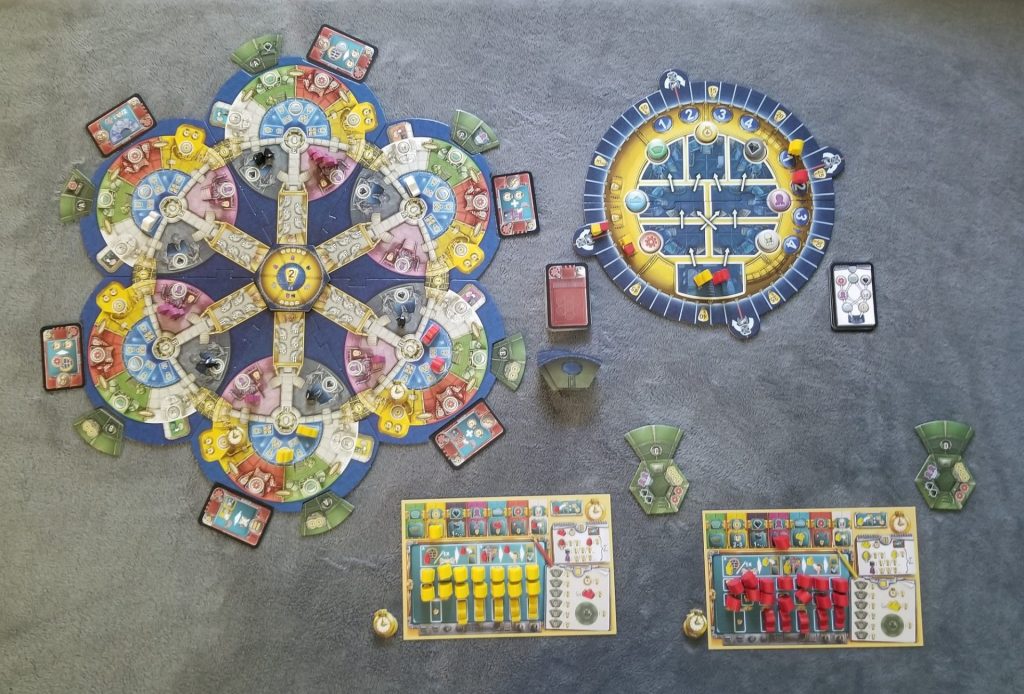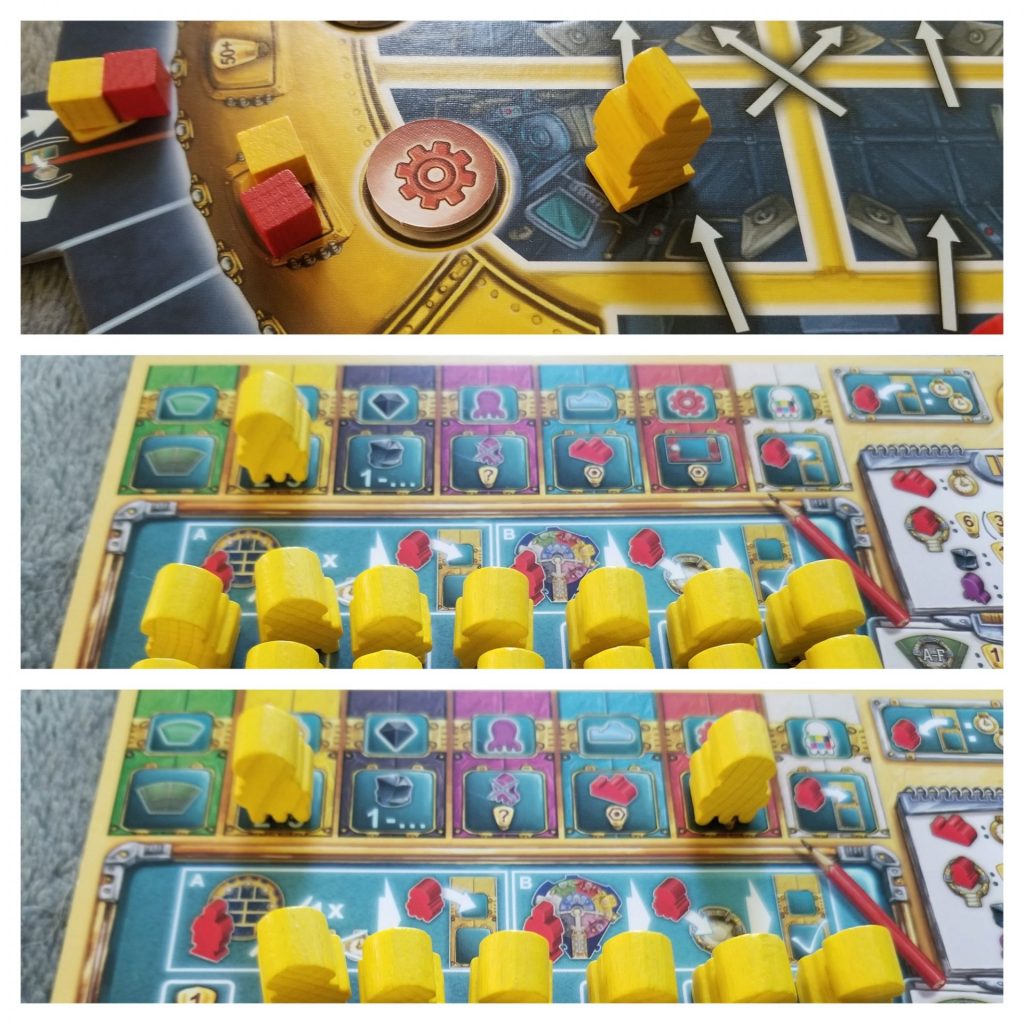Hello and welcome to ‘Focused on Feld’. In this series of reviews, I am working my way backwards through Stefan Feld’s entire catalogue. Over the years, I have hunted down and collected every title he has ever put out. Needless to say, I’m a fan of his work. I’m such a fan, in fact, that when I noticed that there were no active Stefan Feld fan groups active on Facebook, I created one of my own.
Today we’re going to talk about 2014’s Aquasphere, his 21st game.
Aquasphere was originally published by Hall Games in early 2014. Later that year, Tasty Minstrel Games picked it up and ran a successful Kickstarter for the title. Less than a year later, it was released to a wider, non-German speaking public (which is where I first encountered it). In fact, Aquasphere holds the distinction as the first ever Stefan Feld game featured on a crowdfunding platform—and, not counting reprints of previously released titles, the only non-Queen Games title to have been so.
Overview
In Aquasphere, the players take on the roles of a team of researchers at an underwater research station. Players will use their Scientists and Engineers to program their bots to carry out various tasks and collect valuable data about conditions beneath the waves. There are mysterious crystals that need to be gathered, octopods to evict, and more importantly, victory points to be earned.
Aquasphere is an action selection game. On their turn, a player will either use their Engineer to program the player’s bots to determine which actions they can perform or use their Scientist to direct the player’s bots where to perform their actions. Once each player has passed, the round comes to an end and an intermediate scoring will be performed. After four such rounds and intermediate scorings, a final scoring is performed and the player that has accumulated the most points wins.
Of course, this is a very high level overview of the game. If you just want to find out what I think of Aquasphere, feel free to skip ahead to the Thoughts section. Otherwise, keep on reading to find out how the game is played.
Setup
A game of Aquasphere is set up like this:

The game is divided into two central boards—the Research Station (RS), which is composed of six Sectors fitted together in a circular shape, and the Headquarters(HQ)—as well as the players’ personal areas. Each player chooses a color and receives a Player Board, an Engineer, a Scientist, six submarines, sixteen bots, and two counters in their color. After selecting a Starting player, players take turns placing one of their bots on the turn order track according to their position in turn order. Each player will also place a counter on the 0 spaces of the Knowledge and Full Circle Counting tracks and an Engineer onto the first space of the Programming Section of the HQ. The small deck of Program cards is shuffled and the Programming Tiles are laid out in the Programming Section according to the layout on the topmost card. Then that card is returned to the box.
The players place all of their remaining bots and submarines into their starting positions on their Player Boards (one Bot will be leftover) and each player is given a random Base Lab tile. This tile features a letter which indicates the player’s Starting Sector as well as several other icons which indicate the player’s starting storage capacity. The Starting Sector is important for the purposes of the Setup Overview card (which is selected based on the player count). This card indicates which resources and pieces will be allocated to each player’s Starting Sector. This will be the player’s Scientist, a submarine, and some combination of octopi, crystals, and time markers. The card also depicts the starting setup for the unused Sectors in the game.

Along the borders of the different Sectors are arranged randomly drawn cards from the Research card deck as well as randomly drawn Lab Expansion tiles. A stack of 4 Center tiles are created (based on player count) and placed into the center of the RS with the lowest numbered tile on top of the stack. The players will look at the color of the Programming space in their Starting Sector and place their remaining Bot onto the corresponding Program Symbol on their Player Board. Then they will receive four time markers (three if their Starting Sector is adjacent to a ‘0’ lock).
And with that convoluted setup out of the way, you can begin. Thankfully, the actual game play is much easier than the setup.
Anatomy of a Round
Each round consists of players taking turns performing actions until every player has passed. The actions available to a player on their turn are: program a bot, carry out an action with a programmed bot, or pass.
Programming a Bot
A bot cannot carry out an action unless it has been programmed to do so. This can generally be achieved in one of two ways. First, a player may move their Engineer up a space in the Programming Section of the HQ. Each space is connected to another with an arrow. This arrow dictates which path the Engineer must travel. Each space will always have two paths leading out of it. Once a path is chosen and the Engineer is moved, then the player may move one of their bots from the storage on their Player Board onto the matching Program Symbol in the row that runs along the top of the Player Board.

The second method of programming a bot requires the expenditure of time markers. A player may spend three time markers to move a bot from storage to a Program Symbol of their choice. Two of the time markers are returned to the supply and one is left behind on the Player Board on top of the pre-printed time marker in the upper right hand corner.
Regardless of which method the player uses to program a bot, only two bots may be programmed at any given time.
Carrying Out an Action
To carry out an action with a bot, you first have to determine where the action will be performed. This is accomplished by moving your Scientist to the location in whichever Sector you’re wanting to perform the action in, paying an amount of time markers listed on each lock that your Scientist passes through.
In order to perform the action you must have a bot programmed to perform it. The programmed bot is removed from the Program Symbol on your Player Board and is placed into the Control space of the chosen Sector. If a bot is already in that space, it gets displaced and moved to the Loading Station. The Loading Station can only accommodate a certain number of bots. If this number is ever exceeded, each player that has bots there removes all but one of their bots and returns the removed bots to the storage on their Player Board.
Consider the following image:

- This is the Control space.
- This is the Loading Station.
- This is the crystal area. Take as many crystals from the space as you can hold in your supply. This is dictated by the icons on your Base Lab tile as well as any Lab Expansions you may have acquired. We’ll simply refer to this as your ‘Lab’ from here on out.
- Program a bot. This section shows a specific color/symbol. Place a bot from your supply onto the matching Program Symbol on your Player Board. This location is different for each Sector.
- Gain a Lab Expansion tile. Take the topmost Lab Expansion tile and connect it to your Lab. The iconography on the Expansion tile may increase your storage or it may have one or more letters on it. If there are letters, you may place one of your bots from your storage onto the control space(s) of the corresponding Sector(s). Your Lab can only hold a maximum of five Expansion tiles. Once you’ve added a fifth, this action becomes useless to you.
- Take the topmost Research card. These cards provide a variety of effects. Some are instantaneous one-time effects. Others are ongoing. Some only come into effect during scoring. Like the crystals, the amount of these cards that you can hold are limited by the icons in your Lab. You also receive victory points equal to the amount shown in the light bulb on the Center tile of the RS.
- Take time markers. Take as many time markers from the space as you can accommodate. The amount of these that you can hold are limited by the icons in your Lab.
- Remove octopods. The amount of octopods you can remove are limited by the icons in your Lab. Removing these will earn you victory points. The more that you are able to remove at the same time, the more points you’ll earn.
- Place a submarine. Pay the amount of time markers shown on the next empty space and then place one of the submarines from your Player board onto the space. You may only have a single submarine in each Sector. Each submarine placed will earn your victory points equal to the amount shown in the light bulb on the Center tile of the RS.
Once each player has passed, a scoring is performed and then the game is prepared for the next round. New Research cards and Lab Expansion tiles are drawn and laid out (on top of any existing cards/tiles), leftover time markers are removed from the RS, and then additional crystals, time markers, and octopods are placed out into the various Sectors according to the layout specified on the Center tile. Afterwards, the Center tile is removed from the game. The Engineers are returned to the first space of the Programming Section and then Programming Tiles are rearranged according to the topmost Program Card. This card is then discarded.
Scoring
At the end of each round, an Intermediate scoring is performed and after the fourth scoring, a Final scoring is performed. One important aspect of scoring I haven’t mentioned yet regards the scoring track running along the edge of the HQ. This track is divided into segments by a series of lines. In order for a player’s counter to cross a line, the player must pay a crystal. Once passed, the player’s counter can never move backwards over the line.
During Intermediate scoring, players receive victory points for having their bots on the majority of the Control spaces in the RS, points from having bots in play, points for having crystals in their supply (the more, the better), and negative points for having leftover octopods in Sectors where they have a bot on the Control space.
During Final scoring, players receive points for each unique letter shown on the tiles in their Lab (the more, the better), points for leftover time markers, points for having a completed Lab if they have one, and points for having every submarine placed into the RS if they have done so. The player with the most points wins.
Thoughts
Aquasphere arrived in my life long before I became a Stefan Feld junkie. It was on an inauspicious Wednesday night, a game night just like any other. When my friend Matt proposed we play it, what immediately caught my eye was Dennis Lohausen’s incredible box illustration. A bizarre mashup of Star Wars and Sealab with a steampunk flair, the bold illustration of a bustling research laboratory absolutely overrun with pesky octopods made me eager to dig in. Without knowing a single thing about the game I was about to agree to, I was sold.
Prior to Aquasphere, my only other exposure to Stefan Feld was Bora Bora (a game which I adore) and that one left an impression. It put Stefan Feld on my radar. I liked what I’d seen and it felt like this designer knew what he was doing. Aquasphere confirmed it. If I’m being honest, I think that Aquasphere is the game that solidified me as a diehard Feldie.
This is just a brilliant game.
What really stands out for me when playing Aquasphere is just how strongly the theme comes through. With many eurogames, I feel like you could pretty much just move the action from one location to another and the game still works (i.e. changing Bruges to Hamburg or reimagining Alhambra as New York). But that just isn’t so for this game. Aquasphere’s story only works within the framework of an underwater research facility. It is obvious that Feld really put a lot of thought into what it would take to run such a facility and the problems that would arise along the way. This thematic encapsulation of the game’s mechanisms is what makes the game sing.
And the mechanisms themselves aren’t half bad either. I love the way that all of the game’s various cogs mesh together to form a whole that is not only visually attractive, but also challenging as well. There’s just so much to do and so little time to do it that every decision matters. The scarcity of resources makes the competition for those resources fierce. You’ll find yourself constantly warring over time markers and crystals and juxtapositioning to kick your opponents’ bots out of the Loading Stations because every bot not on their Player Boards is going to generate them points. When you do have a decent collection of resources, you’ll find yourself hoarding them like some kind of aquatic Ebenezer Scrooge, grumpily doling them out only when you absolutely have to.
Typically, this would be the point in my review where I’d grudgingly try to come up with a negative, but not this time. I have nothing but praise for this game. Brilliantly imagined, brilliantly realized, Aquasphere constantly throws obstacles in your path, a test at every turn. But the biggest test of all will be playing it without a smile on your face.











Add Comment